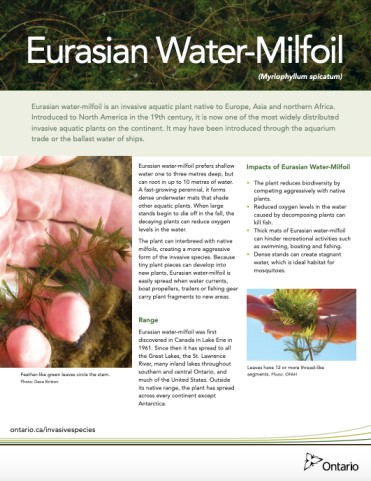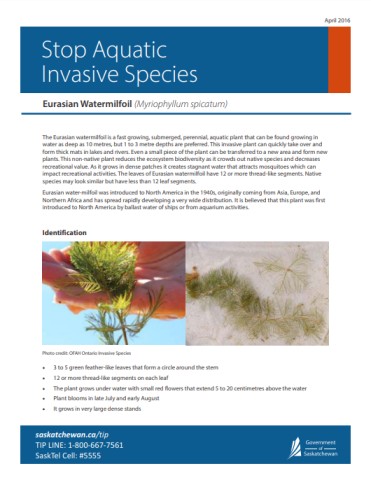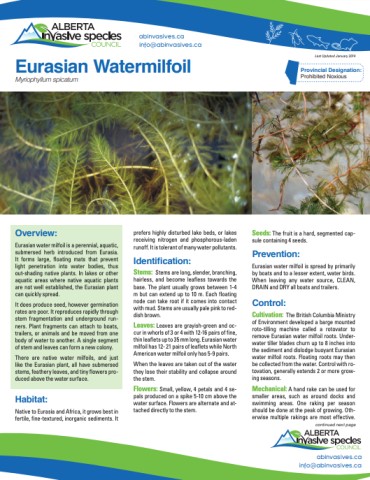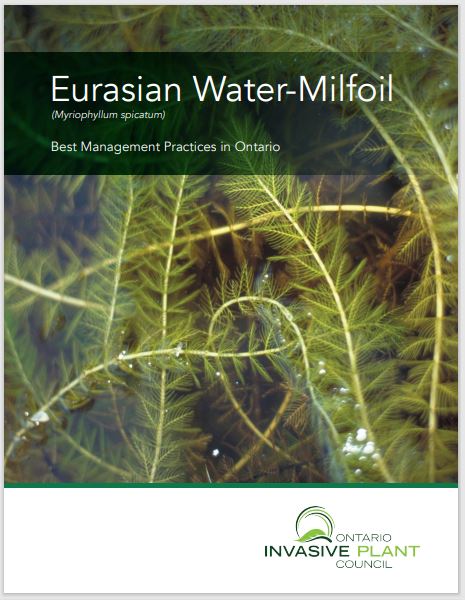Eurasian Watermilfoil (Myriophyllum spicatum)
French common name: Myriophille en épi
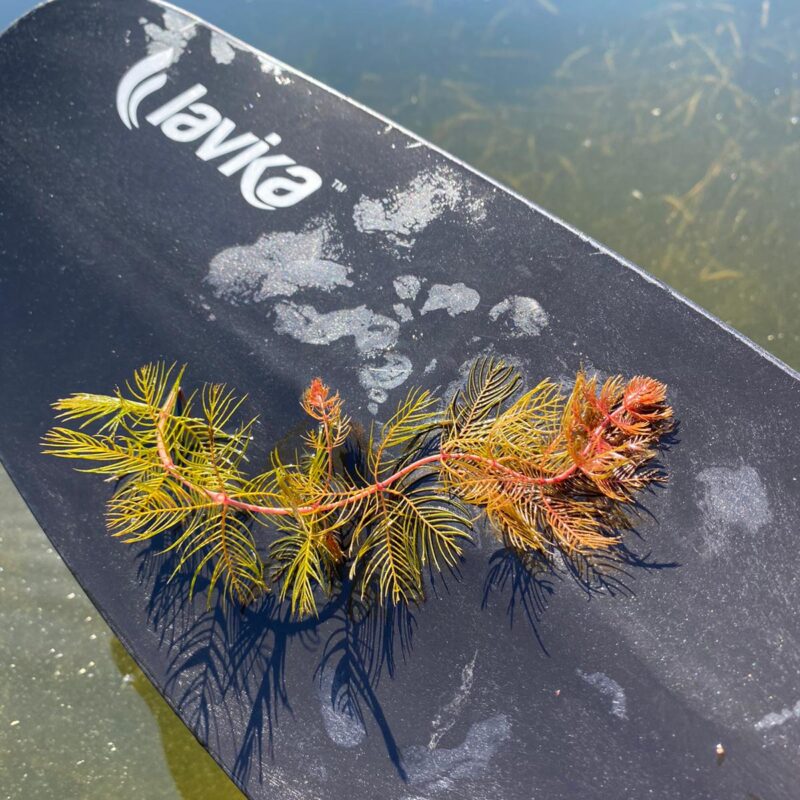
Eurasian watermilfoil prefers shallow water, 1-3 m deep, and can root in up to 10 m of water.
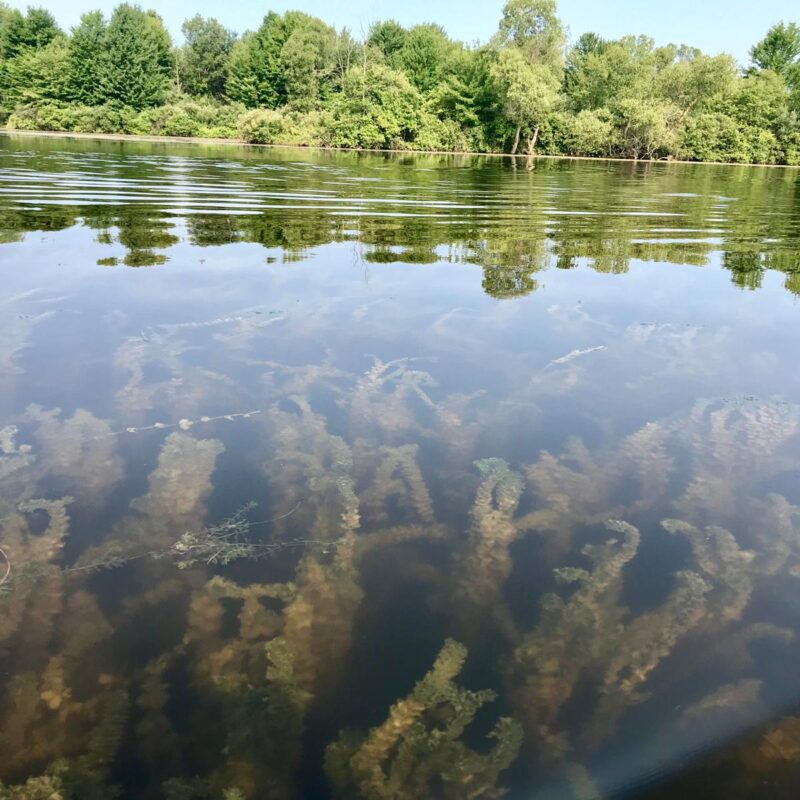
Leaves have 12 or more thread-like segments.
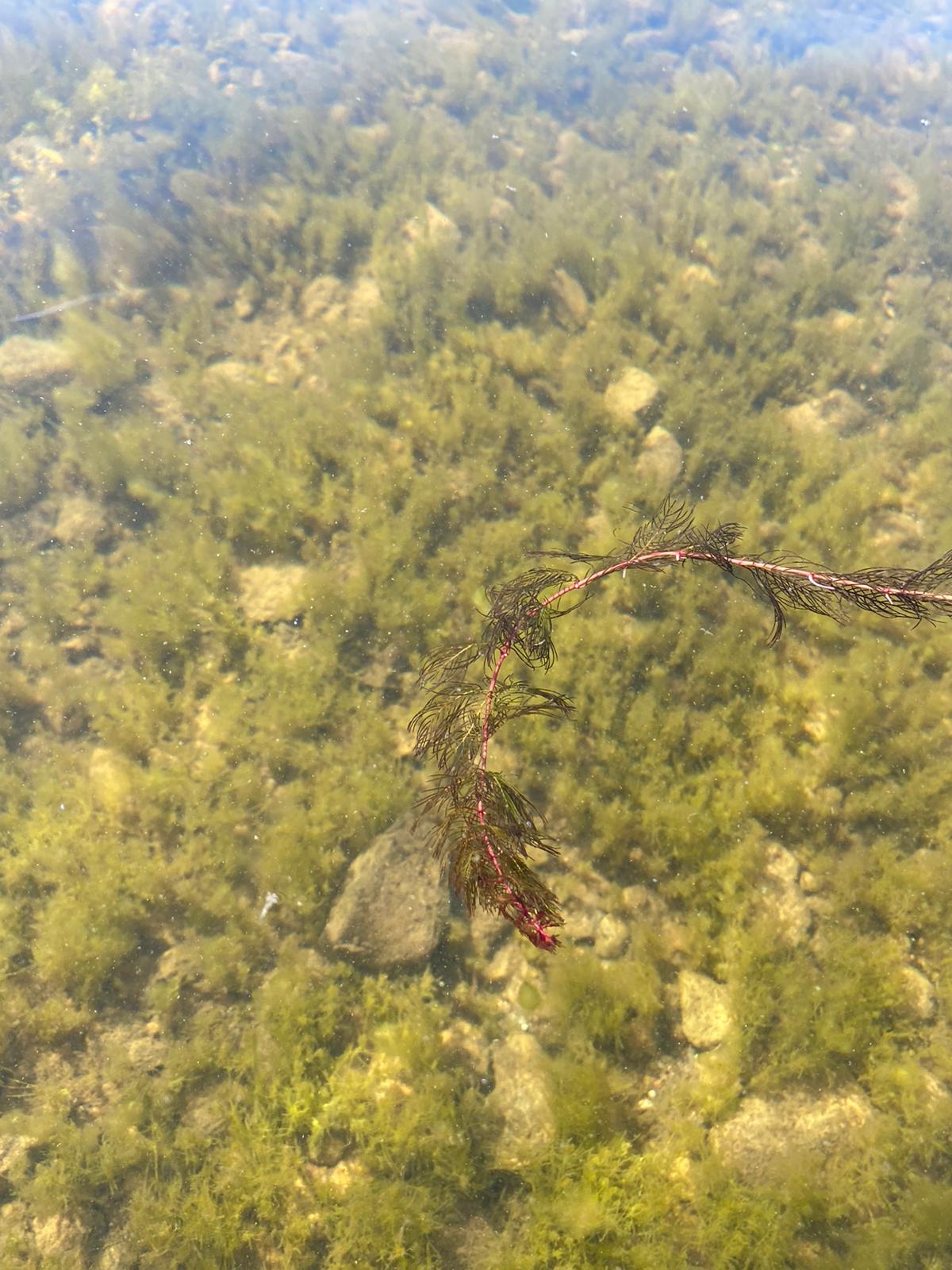
Stands begin to die off in the fall and the decaying plants can reduce oxygen levels in the water.
Order: Saxifragales
Family: Haloragaceae
Did you know? Outside its native range, Eurasian watermilfoil has spread across every continent except Antarctica.
Eurasian watermilfoil is a perennial aquatic plant that grows under the water surface. Its leaves are feather-like with 12 or more thin segments (native milfoil has 11 or fewer leaf segments). Eurasian watermilfoil is most commonly found in water 1-3 m deep (~3-10 ft) in lakes, rivers, and ponds, but can occur at depths up to 10 m (~33 ft). Found in acidic or alkaline waters, this plant blooms small reddish flowers that rise above the water in red tangled stems in July and August. Eurasian watermilfoil grows in thick, dense mats that crowd out native species, reducing biodiversity, and deoxygenate water when decomposing, killing other aquatic species. It can also cause damage to boat motors, negatively impact fishing and swimming, and increase suitable mosquito habitat.
Eurasian watermilfoil is spread through fragmentation of plants and the release of aquarium plants and pets. To prevent its spread, avoid boating through invaded areas, wash all recreational equipment, and never release or compost unwanted aquarium vegetation.
Eurasian watermilfoil has slender stems up to 2.5 m (8.2 ft) long. The plant is a perennial that grows under the water surface and has feather-like green leaves that circle the stem in groups of four or five. Eurasian watermilfoil blooms in late July and early August and has orange/red flowers that are 4–6 mm long. Flowers are produced in the leaf axils on a spike that can be 5–20 cm long, held vertically above the water surface.

Eurasian watermilfoil was discovered in Canada in Lake Erie in 1961. Since its first spotting, Eurasian watermilfoil has spread throughout all of the Great Lakes, the St. Lawrence River and inland lakes throughout Ontario. Currently, Euarsian watermilfoil is present in three Canadian provinces: Ontario, Quebec, and British Columbia.
Eurasian watermilfoil is spread through the transportation of recreational boats, fishing equipment, and any other equipment that can come in contact with this invasive plant. The plant can spread when fragments are attached to equipment and transported to another body of water. It is important to clean, drain, and dry all outdoor equipment. Find more information on our prevent the spread page.
Eurasian watermilfoil is threatening Canadian waterways by competing directly with native plants and reducing biodiversity. Thick mats of Eurasian watermilfoil prevent other native plants and native fish species from thriving within the ecosystem.
Eurasian watermilfoil can reduce the amount of oxygen within the ecosystem, making it difficult for other species to survive. In the fall, when large mats of Eurasian watermilfoil die off, the decaying plants can reduce oxygen levels within the water.
Large, thick mats of Eurasian watermilfoil impact recreational activities such as swimming, boating, and fishing. This invasive plant hinders boats from propelling through and often does not provide suitable conditions for fishing.
Learn how to identify Eurasian watermilfoil and avoid accidentally spreading this plant with your watercraft or fishing equipment.
- Learn the key ID features of Eurasian watermilfoil.
- Avoid infested areas or reduce your speed when travelling near Eurasian watermilfoil infestations. Your propeller can break off fragments and spread the pieces to new areas. New plants can grow from small pieces of the plant.
- Inspect your boat, trailer, and equipment after each use. Remove all plants, animals, and mud before moving to a new waterbody. Learn more about the process of clean, drain, dry.
- Avoid planting Eurasian watermilfoil in your aquarium or water garden. Aquarium hobbyists and water gardeners should only use native or non-invasive plants and are encouraged to ask retailers for plants that are not invasive.
- Never release unwanted aquarium plants or pets. Return or donate unwanted plants to a garden centre or pet store, or put them in the garbage. Do not put them in the compost or discard them in natural areas. Discarded plants may produce seeds that can sprout.
- If you’ve seen Eurasian watermilfoil report the sighting.
Parrot feather (invasive)
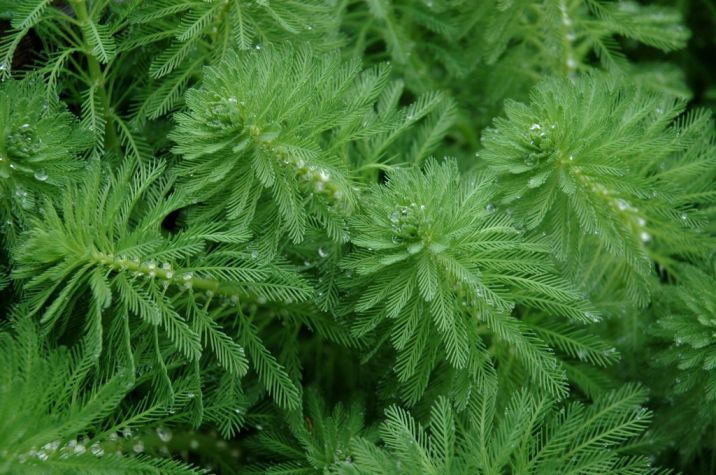
Invasive parrot feather is common in the aquarium trade. It has leaves that rise above the surface of the water, while only the terminal flower spike of Eurasian watermilfoil emerges from the water. Parrot feather is a prohibited species under the Ontario Invasive Species Act, meaning it is illegal to import, possess, deposit, release, transport, breed/grow, buy, sell, lease or trade this species in Ontario.
Fact Sheets
Research
[PDF] Ecology of Eurasian watermilfoil.
propagation and mineral nutrition of Eurasian watermilfoil are emphasized, as are effects of
environmental factors on the distribution, productivity, and growth form of this species, its …
[PDF] The decline of native vegetation under dense Eurasian watermilfoil canopies
consistently and expansively from 1987 through 1989, suppressing native plant species.
The total number of species found within the 3 mº grid system in the Eurasian watermilfoil …
[PDF] The production biology of Eurasian watermilfoil (Myriophyllum spicatum L.): a review
currently considered to be a very troublesome weed, particularly throughout the Eastern
United States (7, 14, 50, 65, 72). Its rapid and effective dispersal, largely as plant fragments …
[PDF] Predicting invasion success of Eurasian watermilfoil
exotic species might improve both the planning and implementation of management for
invasions in new areas. Data from lakes containing Eurasian watermilfoil were evaluated to …
[PDF] Vegetative spread of Eurasian watermilfoil colonies
and fragment production. Clonal expansion primarily by stolons provides Eurasian
watermilfoil with a means of localized spread, while intermediate distance expansion is …
Loss of native aquatic plant species in a community dominated by Eurasian watermilfoil
frequently a combination of historical data prior to introduction and after full establishment
with little observation in between. The introduction of Myriophyllum spicatum L.(Eurasian …
Eurasian watermilfoil as a fishery management tool
as it continues to spread and multiply in North American waters. Some of its effects can be
detrimental to fisheries. When dense, the plant obstructs swimming space of pelagic fishes …
Photosynthesis in Eurasian watermilfoil (Myriophyllum spicatum L.)
2 compensation point and a high temperature optimum for photosynthesis. These properties
are characteristic of plants fixing CO 2 by a β-carboxylation mechanism. Operation of the …
[PDF] Fluridone concentration and exposure time requirements for control of Eurasian watermilfoil and hydrilla
concentrations reached zero, herbicide removal from the water col-This study was
conducted in a controlled-environment umn was complete. Residue analyses from previous …
[PDF] Response of Eurasian watermilfoil to 2, 4-D concentrations and exposure times
1976. Studies of Aquatic Macrophytes Part 2,4-D threshold concentrations for control of Eurasian
watermilfoil X. A field experiment with granular 2,4-D for control of Eurasian and sago …
Growth and developmental performance of the milfoil weevil on distinct lineages of Eurasian watermilfoil and a northern x Eurasian hybrid
Borrowman, K. and E. Sager and R. Thum. 2015. The Growth and Developmental Performance of E. lecontei on Two Biotypes of M. spicatum and Hybrid Milfoil (M. spicatum x M. sibiricum) Present in Ontario, Canada. Journal of Aquatic Plant Management 53:81-87.
Recent identification of two genetically distinct lineages of Eurasian watermilfoil (Myriophyllum spicatum L.) and hybrid M. spicatum x M. sibiricum Kom. populations in Ontario, Canada has lead to emerging concerns surrounding the efficacy the milfoil weevil…
Distribution of biotypes and hybrids of Myriophyllum spicatum and associated Euhrychiopsis lecontei in lakes of Central Ontario, Canada
Borrowman, K.R., E.P.S. Sager, and R.A. Thum. 2014. Distribution of biotypes and hybrids of Myriophyllum spicatum and associated Euhyrchiopsis lecontei in lakes of central Ontario. Lake and Reservoir Mangement 30:94-104
Eurasian watermilfoil (Myriophyllum spicatum) has been present in Ontario’s waterways since the 1960s, leading to various forms of mechanical, chemical, and biological control to manage nuisance milfoil growth…
Current Research and Knowledge Gaps
Eurasian Watermilfoil Research at MAISRC
MAISRC research on Eurasian watermilfoil focuses on finding biological controls; integrating control with enhancement of native plants; and studying the distribution, ecology, and management of hybrid watermilfoil that arises from Eurasian watermilfoil crossing with the native species, northern watermilfoil
Further Reading
The Invasive Species Centre aims to connect stakeholders. The following information below link to resources that have been created by external organizations.

